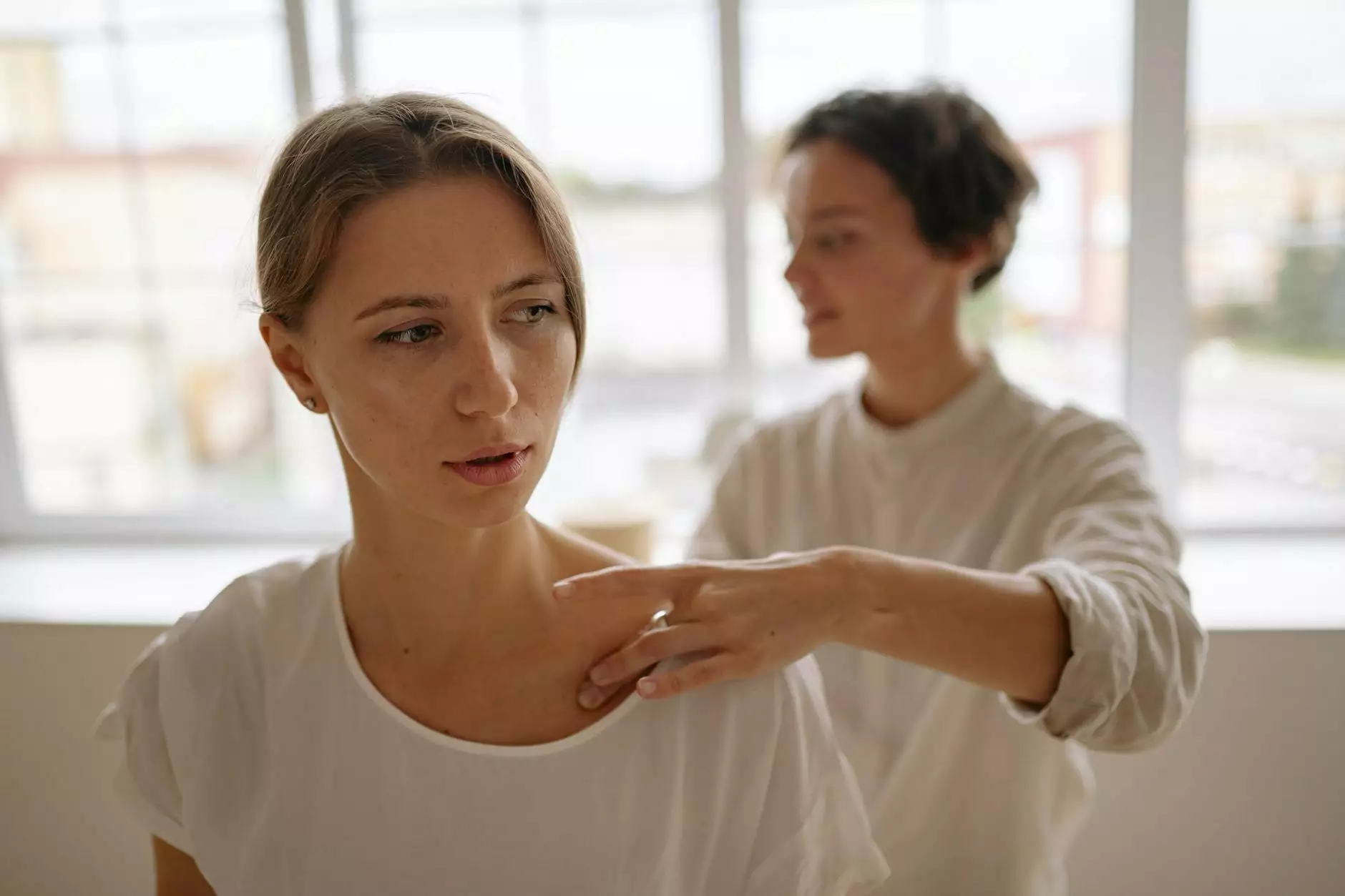Understanding the Capsular Pattern of Glenohumeral Joint: A Comprehensive Guide for Healthcare & Education

The glenohumeral joint is one of the most complex and mobile joints in the human body, enabling a wide range of motion essential for daily activities and athletic pursuits. A critical aspect of its function and pathology involves understanding the capsular pattern of glenohumeral joint, which is fundamental for accurate diagnosis, effective treatment, and rehabilitation of shoulder conditions.
Introduction to the Anatomy of the Glenohumeral Joint
The glenohumeral joint is a ball-and-socket synovial joint formed between the head of the humerus and the glenoid fossa of the scapula. It is stabilized by a network of static and dynamic structures, including the joint capsule, ligaments, labrum, tendons, and surrounding muscles. The joint's extensive range of motion is primarily attributed to its loose capsule and shallow socket, making it susceptible to various injuries and degenerative changes.
The Role of the Joint Capsule and Ligaments
The joint capsule is a fibrous envelope that encloses the glenohumeral joint, providing stability while allowing mobility. It attaches proximally around the margin of the glenoid and distally to the anatomical neck of the humerus. The capsule is reinforced by several ligaments, including the superior, middle, and inferior glenohumeral ligaments, which collectively control the extremes of movement and restrict excessive motions.
The capsular tissues contain synovial fluid that lubricates the joint and nourishes the articular cartilage. Any pathological change in the capsule, such as fibrosis, inflammation, or contracture, significantly impacts the joint's range of motion and function.
Defining the Capsular Pattern of Glenohumeral Joint
The capsular pattern of a joint is a characteristic pattern of restriction that occurs during passive movement, reflecting the involvement of specific portions of the joint capsule or associated structures. For the glenohumeral joint, the capsular pattern is notably predictable and assists clinicians in diagnosing the type and extent of shoulder pathology.
What is the Typical Capsular Pattern of the Glenohumeral Joint?
The classic capsular pattern of glenohumeral joint involves greater restriction of movements in a specific sequence, primarily characterized by:
- External rotation limitations
- Abduction restrictions
- Internal rotation limitations
This sequence indicates that in conditions affecting the entire capsule, external rotation is most compromised, followed by abduction and internal rotation. Recognizing this pattern helps healthcare professionals differentiate between joint capsule contractures and other etiologies such as rotator cuff pathology or impingement syndromes.
Pathological Variations in Capsular Patterns
While the typical pattern involves restrictions in external rotation, abduction, and internal rotation, various pathological states can alter this pattern:
- Adhesive capsulitis (frozen shoulder): Characterized by marked restriction in all ranges of motion, but especially external rotation and abduction.
- Arthritis: Often presents with generalized stiffness but may show more prominent restriction in specific movements depending on joint degeneration.
- Capsular tightening due to post-traumatic or post-surgical adhesions: May alter the normal sequence of restriction, emphasizing the importance of detailed clinical assessment.
Clinical Significance of Recognizing the Capsular Pattern
Understanding the capsular pattern of glenohumeral joint is vital for several reasons:
- Accurate diagnosis of shoulder conditions such as adhesive capsulitis, arthritis, or traumatic stiffness
- Guiding treatment strategies focusing on specific ranges of motion
- Monitoring progress during rehabilitation by assessing changes in movement restrictions
- Distinguishing joint capsule restrictions from muscular or neurological limitations
Assessment Techniques for Capsular Pattern Diagnosis
Effective clinical assessment involves detailed passive and active range of motion (ROM) testing, palpation, and imaging when necessary. Key steps include:
- Passive Range of Motion Testing: Systematic evaluation of external rotation, abduction, and internal rotation to identify restrictions and their severity.
- Comparison to Contralateral Shoulder: Establishing normative data for individual patients.
- Assessment of Pain Patterns: Correlating ROM limitations with pain to determine if the restrictions are due to capsular tightness or other pathology.
- Imaging Modalities: MRI or ultrasound can confirm capsular thickening, fibrosis, or other structural changes correlating with clinical findings.
Rehabilitation and Treatment of Capsular Restrictions
Management of conditions involving the capsular pattern of the glenohumeral joint should aim to restore normal motion, reduce pain, and improve functional capacity. Common therapeutic approaches include:
- Physical therapy: Focused on stretching and mobilization techniques such as joint oscillations, specific capsular stretching, and manual therapy.
- Modalities: Use of heat, ultrasound, or electrical stimulation to reduce inflammation and muscle guarding.
- Exercise programs: Strengthening surrounding muscles to support joint stability post-mobilization.
- Invasive procedures: Arthrographic distension or capsular release in severe cases like refractory adhesive capsulitis.
Preventive Strategies and Health Promotion
Prevention of capsular constriction and shoulder stiffness involves proactive measures, including:
- Regular shoulder mobility exercises especially for individuals with sedentary lifestyles or repetitive overhead activities.
- Timely management of shoulder injuries to prevent fibrosis and chronic stiffness.
- Addressing post-surgical or post-trauma complications with appropriate physical therapy protocols.
Importance of Specialized Knowledge for Health and Educational Professionals
For professionals in the health and medical sectors, especially chiropractors and physical therapists, a deep understanding of the capsular pattern of glenohumeral joint is indispensable. This knowledge enhances diagnostic accuracy, informs targeted interventions, and promotes optimal patient outcomes.
How Education Enhances Outcomes in Shoulder Care
Educational initiatives that focus on shoulder anatomy, capsular patterns, and assessment techniques are essential for continuous professional development. Online platforms, workshops, and clinical training programs foster mastery of these skills, ultimately leading to improved patient satisfaction and functional recovery.
Conclusion: Embracing a Holistic Approach to Shoulder Health
The capsular pattern of glenohumeral joint is a fundamental concept that integrates anatomy, clinical assessment, and therapeutic management. Recognizing and understanding these patterns empowers healthcare providers to deliver precise, individualized treatments, thereby accelerating recovery and enhancing quality of life for patients with shoulder disorders.
At iaom-us.com, our commitment to advancing health, medical, and educational excellence continues through innovative programs and expert resources. Whether you are a clinician, therapist, or student, staying informed about critical joint assessments like the capsular pattern of glenohumeral joint is vital for excelling in your practice.
References & Further Reading
- Moore, K. L., Dalley, A. F., & Agur, A. M. R. (2014). Clinically Oriented Anatomy. Lippincott Williams & Wilkins.
- Lippincott Williams & Wilkins. (2011). Orthopedic Physical Assessment. David J. Magee.
- Neumann, D. A. (2010). Kinesiology of the Musculoskeletal System: Foundations for Rehabilitation. Elsevier.
- Research articles on capsular patterns and shoulder pathology from reputable journals such as the Journal of Orthopaedic & Sports Physical Therapy.
By comprehensively understanding the capsular pattern of glenohumeral joint, practitioners can significantly improve diagnostic precision and treatment efficacy, ensuring patients regain optimal shoulder function and mobility.









